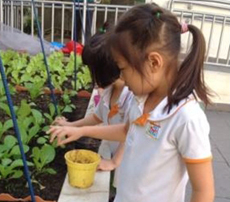Reflections of My time with Marine Life

Volunteers hard at work sorting the specimens collected.
Not many students can say that they have interned at a research laboratory, preserved a marine creature or had been a part of one of Singapore's largest conservation project. I can proudly say I have done all three. Under my school's Construct Integrate Differentiate (CID) curriculum (science cluster), my friends and I were given the chance to sign up for a one-month attachment to NUS Tropical Marine Science Institute (TMSI).
As part of our attachment to TMSI, we were to help out at OBS Pulau Ubin, where the Comprehensive Marine Biodiversity Survey (CMBS) would take place. And that was how the five of us came to be volunteers in the biggest marine survey in Singapore.
At a volunteers briefing, we were told the aims of the CMBS, which is to take stock of Singapore's marine biodiversity, build local capacity in the field of marine biology, spread awareness and increase appreciation of our marine natural heritage.
It sounded so foreign to us because we did not know what to expect, much less how to help achieve those big goals. Being nature and animal lovers, we were all excited about the prospect of working with marine animals (though we would prefer it if they were still alive). But beyond that, none of us knew what we were in for, since we had never participated in any conservation projects before. Dr Lee Yen Ling, our mentor in TMSI did her best to prepare us for our volunteering stint by training us in identifying, cataloging and photographing specimens, as well as share with us how the actual event would be carried out.
But still, nothing could have prepared us for the adventure ahead of us.
Through the weeks of volunteering at the sorting shed in CMBS, I have gained many insights on marine animals and conservation and was pleasantly surprised by the rich marine life that can be found in Singapore.
As marine biology is not taught in the school biology curriculum, it was a refreshing and enriching experience to learn about an entirely different area of science.

Volunteers sorting specimens from a survey trip.
We were exposed not only to creatures of the sea, but were taught valuable research skills, such as photography, preservation of specimens, documentation and even had a taste of cryogenics (Cryogenics is the study of the behavior of materials in extremely cold temperatures). Preservation was the most interesting experience for me, especially when I had the chance to –preserve animals with formalin. At first, I was hesitant to do so because I felt bad, even though the animal was already dead.But, after the first trial on a fish, I started to get used to the -technique and found the process -interesting. I still remember squealing in delight when I successfully preserved my first fish, much to the amusement of our mentor.

Washing up equipment from survey trip.
Our lack of experience in identifying marine species posed a major obstacle. Naturally, because I had never been exposed to this field of science, it was difficult for me and my fellow schoolmates to identify the group of organism or whether it was even a living thing in the first place. Sometimes, we missed the creatures due to their camouflaging abilities or we just were unaware that there are such marine animals.
Often, a more experienced researcher would sift through our discarded pile and say: "Aha! That's a nudibranch right there!" (Or an ostrocod, or a sea fan, etc). We had mistaken them for bits of plastic, or specks of dirt, or just ruled them out as shells! And there were times we would pick out bits of plastic and put them with the "bryozoans" , which are moss animals, much to the horror of the bryozoan researchers.

"That's me (2nd from the right) outside the sorting shed with my schoolmates before leaving on a trip to the mudflats."
All in all, student volunteers and I are grateful for the guidance provided by the experienced and passionate researchers at CMBS. Through conversations with them as well as through many weeks of sorting, I have learnt a lot of new marine organisms, which I previously have never heard of.
Also, as many researchers were specialists they provided in-depth explanations of the anatomy of the animals or their behavioural habits. For example, Dr Daphne Fautin is an expert in sea anemones. She often took the initiative to explain to us about anemones and the wide variety Singapore has, thus developing in us an interest in marine biology. She also shared her experiences working in the field of marine biology with me, and because of this, I am now considering a career in marine biology.
By Thaddea Chua
Author Note
Thaddea Chua is a River Valley High School who is interested in biological science. She loves nature and is interested in conservational efforts for marine life. She spent three weeks with the Comprehensive Marine Biodiversity Survey team between October to November 2012.
Comprehensive Marine Biodiversity Survey
The Comprehensive Marine Biodiversity Survey (CMBS) is a project sponsored by Asia Pacific Breweries, the Care-for-Nature Trust Fund and Shell Companies in Singapore. It aims to discover all the fauna and flora that can be found in all of Singapore's marine habitats, ranging from mudflats, rocky shores, coral reefs and the seabed. Other than tertiary institutions, the survey also engages the community in the form of volunteers to increase the awareness of our marine natural heritage.
If you are interested to sign up as a volunteer, please contact Kwan Siong at koh_kwan_siong@nparks.gov.sg.





Have views or comments on this article? Let us know via this form. If you would like to give us feedback on any other areas relating to our parks and gardens, please submit via https://www.nparks.gov.sg/feedback